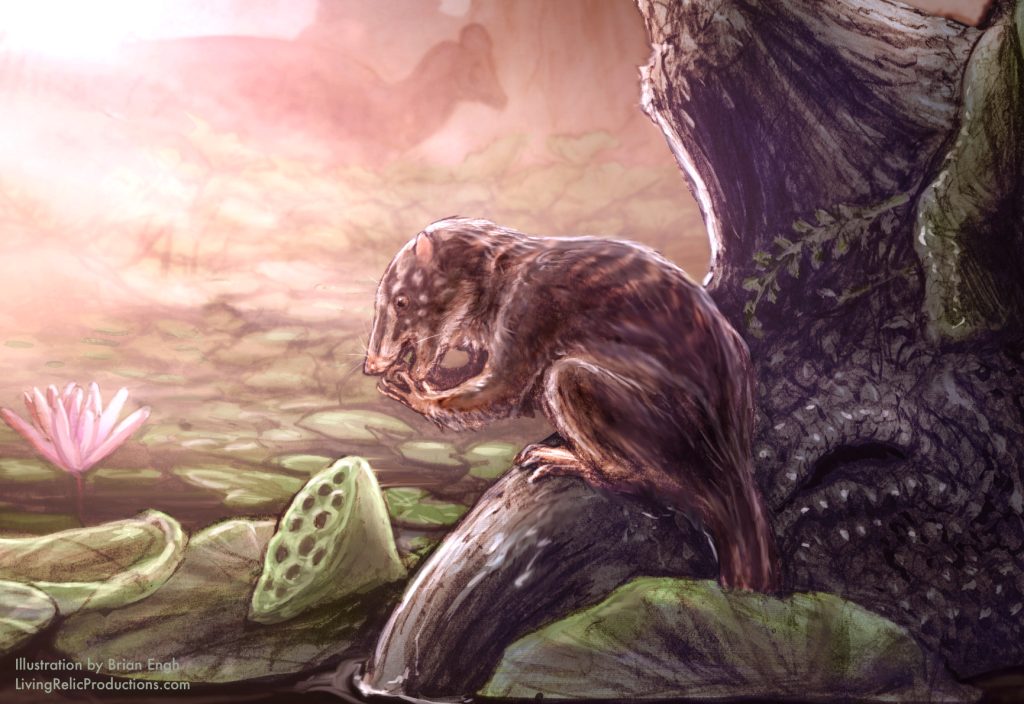New Fossil Mammal Was A “Giant” of the Cretaceous
72 million years ago, in what is now northwestern Colorado, a mammal lived in a swampy area similar to modern-day Louisiana – a mammal significantly larger than its other furry contemporaries

VERNAL — A research team of paleontologists from Utah State Parks, Dinosaur National Monument, the University of Colorado, Loyola Marymount University, and Appalachian State University have described a collection of fossil teeth and a jaw belonging to a big, new mammal from the Cretaceous Period near the Colorado-Utah border. Unknowingly collected in 2016, and found during the preparation of rock from a site near Rangely, Colorado, in 2018, the most complete element attributed to the new mammal is a jaw fragment with three molars, each of which is nearly five times larger than typical mammal teeth found in the same rocks.
The new, muskrat-sized mammal is named Heleocola (“swamp dweller”) and lived roughly 75 to 70 million years ago in the wet forests of a large river delta, similar to that of today’s Mississippi River, that existed in northeastern Utah and northwestern Colorado at the time.
Most mammals during the age of dinosaurs were rather small, shrew- to chipmunk-sized. But lead author of the study, University of Colorado’s Jaelyn Eberle, explained, “They’re not all tiny. There are a few animals emerging from the Late Cretaceous that are bigger than what we anticipated 20 years ago.”
While Heleocola is not the largest mammal known from the Cretaceous, most mammal teeth known from its time and area are less than 1/16th of an inch long, whereas Heleocola’s molars are about 1/4th of an inch long each. In contrast to the several ounces that most mammals of the time weighed, Eberle estimates that Heleocola weighed 2 pounds or more.
The jaw fragment with three teeth is about an inch long and slightly over half an inch deep. Study co-author John Foster of the Utah Field House of Natural History State Park Museum first recognized the jaw piece when it had just emerged from the rock thanks to the careful preparation work of Museum of Western Colorado volunteer Tom Lawrence.
“The jaw, the teeth, everything was so much bigger than most mammal fossils you see out of the Cretaceous rocks around there. I thought that’s huge!” Foster said.
Later analysis of the sandstone in which the jaw was found, done in cooperation with the United States Geological Survey in Denver, has indicated that the jaw is approximately 72 million years old.
Heleocola probably lived in its forested environment surrounded by rivers and swampy bayous, with estuaries and the Western Interior Seaway to the east.
“The region might have looked a bit like Louisiana,” said study co-author ReBecca Hunt-Foster, park paleontologist at Dinosaur National Monument. “We see a lot of animals that were living in the water quite happily, like sharks, rays, and guitarfish.”
Hunt-Foster and Foster have been working in northwestern Colorado and northeastern Utah to dig up Cretaceous fossils every summer for about 15 years. Other creatures that have been found in the same rocks as Heleocola include fish, turtles, lizards, small and giant crocodiles, amphibians, duck-billed and horned dinosaurs, and meat-eating tyrannosaurid and dromaeosaur dinosaurs. There are also a few other, smaller mammals. “This delta seems to have been packed with a wide variety of animals on land and in the water,” Foster said.
“Colorado is a great place to find fossils, but mammals from this time period tend to be pretty rare,” said Eberle. “So, it’s really neat to see this slice of time preserved in Colorado.”
“We have scientists that come from all over the world specifically to study our fossils,” Hunt-Foster said. “We really are lucky.”
The researchers published their findings on October 23rd in the journal PLOS ONE (see https://journals.plos.org/plosone/article?id=10.1371/journal.pone.0310948).
If you found this blog entry interesting, please consider sharing it through your social network.